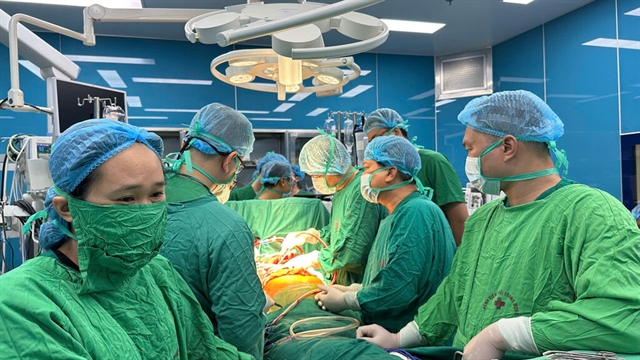 Sunday/Weekend
Sunday/Weekend

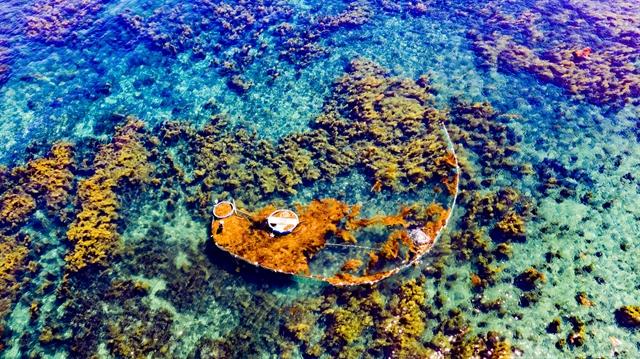 |
| BIRD'S-EYE VIEW: Harvesting seaweed in Bình Châu Commune, Quảng Ngãi Province. VNS Photo Phạm Anh |
At the crack of dawn, hundreds of fishermen from the coastal communes of the central province of Quảng Ngãi sail their coracles to the sea to harvest a special gift of nature bestowed upon their homeland: seaweed.
Containing a wide range of vitamins and minerals, including iodine, iron and calcium, seaweed is increasingly favoured due to its high nutrition and original taste.
To the locals, besides onions and garlic, this “sea vegetable” is another plant that has brought them a significant source of income.
The harvest season of seaweed starts at the beginning of July when clumps of seaweed appear abundantly on the cliffs and coastal coral reefs. According to local fishermen, this plant grows and thrives from mid-April to July every year.
Sitting in his boat, 52-year-old Nguyễn Hùng from Châu Thuận Village in Bình Châu Commune points at the bubbles on the water surface, explaining: “Some villagers are diving in this area to cut seaweed.”
Emerging from the transparent blue water is a young man wearing a diving mask, swimsuit and oxygen tube. After resting for a few minutes, he continued to dive from two to five metres from the surface.
The net is cast around the diver’s position to gather the seaweed floating after being cut. Another fisherman on the boat hastily uses a long pole or a racket for fishing out the seaweed and places them onto a nearby raft or basket. If they are slow, water might push the seaweed out of the net, making it difficult to be collected.
According to Hùng, the seaweed harvest typically starts at around 5am and ends in the late afternoon. Many fishermen and divers also bring food to have lunch by the sea.
A day’s dive could collect 400 to 500kg of fresh seaweed. After drying, each tonne of wet seaweed will reduce to 300-350kg of dried seaweed, depending on its age.
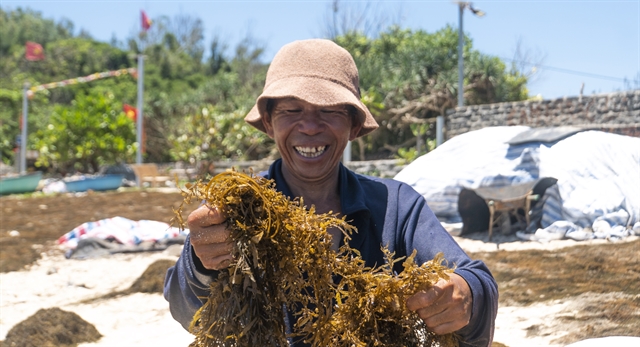 |
| HARVEST SEASON: Fisherman Nguyễn Hoàng, 51, from Châu Thuận Biển Village, Bình Châu Commune is happy to have a successful seaweed season this year. VNS Photo Phạm Anh |
Families of many members often invest in specialised equipment like oxygen tanks and rafts, while the work is divided clearly. Those with limited budgets might wait until the tide has ebbed in the late afternoon to pull their rafts and collect the seaweed along the shore until night.
Exploitation combined with conservation
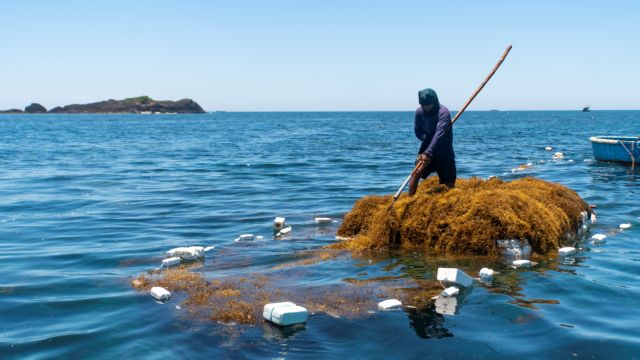 |
| OCEAN'S BOUNTY: A fisherman uses a long pole for fishing out the seaweed and places it onto a nearby raft. VNS Photo Phạm Anh |
Fishermen in coastal communes such as Bình Hải or Bình Châu in Quảng Ngãi have a successful season this year when the demand of the market is high. Traders immediately purchase all the freshly harvested seaweed.
“In the past three weeks, my family could earn about VNĐ1.5 million (US$64) per day from seaweed. The price of one kilo last year was only VNĐ6,000, but it has increased up to VNĐ9,000 this year, so locals are happy to go to sea, no matter how hard the work is,” Nguyễn Văn Phụng from Phú Quý Village in Bình Châu said.
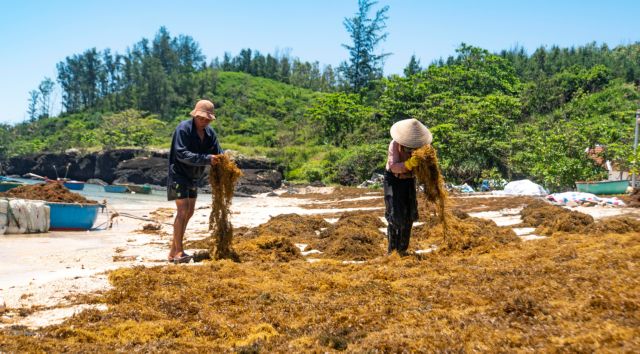 |
| PROCESSING: Fresh seaweed is dried naturally under the sun for 3 to 5 days before being ready for use. VNS Photo Phạm Anh |
Collecting the “sea vegetable” is more accessible and less expensive than fishing. The fishermen only need to row a coracle or a small motor boat 600-800m from the shore to cast their net and begin diving.
However, according to Phụng, harvesting seaweed is arduous. It is an aquatic alga that grows on the sandy bottom about 1-1.5m below the water surface. Therefore, divers are normally male and must be in good health to stand the sun and wind and be able to dive for a long time underwater. The elderly and children can also earn extra income by collecting seaweed by the shore and drying it for other households.
The harvest season of seaweed mainly runs from June to August. Most fishermen focus on harvesting seaweed instead of seafood at this time of the year. They say this year’s season may end sooner than usual.
After being harvested, seaweed is initially processed to remove garbage and rocks that still cling to the root. Then it must be dried naturally under the sun for 3 to 5 days before being ready for use.
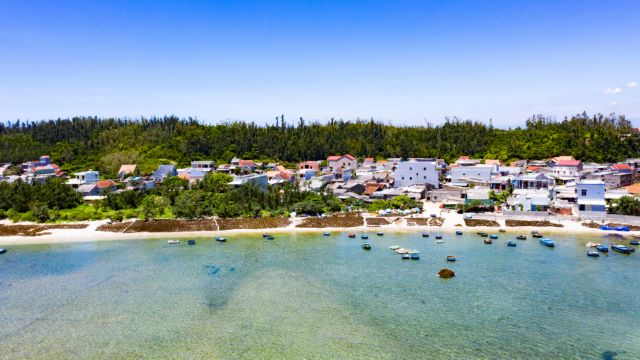 |
| PICTURE PERFECT: Fresh seaweed is dried along the coast of Quảng Ngãi Province. VNS Photo Phạm Anh |
Dried seaweed has become a famous speciality of Quảng Ngãi. It can be cooked into many delicious and nutritious dishes with simple methods like soups or salads, so the plant has become increasingly favoured.
Harvesting seaweed can bring high economical efficiency and reduce pollution caused by old plants drifting ashore. However, over-exploitation a few years ago seriously affected the marine ecological environment.
Among the varieties of seaweed, sargassum, which grows mainly on coral reefs, is a food source and creates a place for other species to shelter and reproduce. It also creates a favourable environment for dozens of coral species to develop.
To avoid any negative effects, the Quảng Ngãi provincial authority has specified the time for exploitation. Accordingly, the harvesting, trade and transport of seaweed are forbidden in the province from December 1 to the end of April of the following year, except for research work approved by the authority.
Local fishermen are allowed to harvest seaweed after May 1 every year. They must not uproot the plant but cut at least 10cm from the root and must not exploit over 75 per cent of the seaweed area for aquatic species to have a shelter to reside and reproduce. At the same time, they should avoid trampling or anchoring ships in the seaweed area in order not to damage the coastal coral reefs.
The regulations are based on the plant's growth characteristics, ensuring its growing standards and preserving spawning grounds for aquatic species.
“Thanks to seaweed collecting, local fishermen have had a decent income for their living,” said Nguyễn Ngọc Tài, deputy director of the Quảng Ngãi Agricultural Promotion Centre. The commune now has about 400 households harvesting seaweed.
“Local authorities have encouraged fishermen to exploit seaweed properly in combination with preservation. Harvesting the plant must be done in the right season, otherwise, it will affect the growth of fish and shrimp," he said.
"Local fishermen are well aware of its importance and strictly follow the regulations.”
According to Tài, it is necessary to develop seaweed farming and exploit the potential areas suitable for growing species with high economic value, not to waste resources.
He also stressed the importance of calling for business investment in indigenous seaweed species to turn them into processed products with high added-value, which is also a direction to restructure the agricultural work in the fisheries sector and for rural development. VNS


